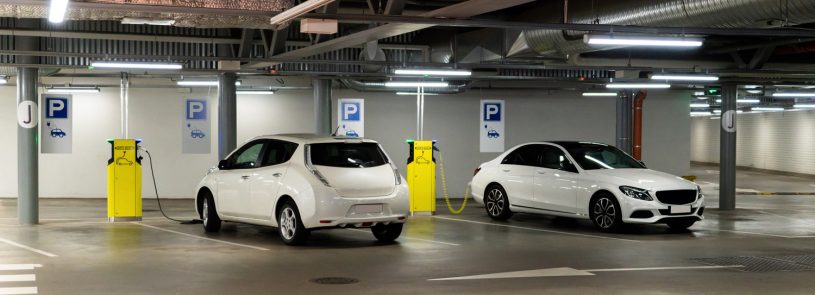EV charging stations: Designed right, they can lead to building energy savings

By Mike Lawless and Zach Carter
One byproduct of the coming exponential growth of electric vehicles (EV) will be a growing demand for charging stations away from EV owners’ homes. Workplace parking lots and public parking garages will be ideal locations for these stations but building owners may find their infrastructure inadequate to support them.
Accommodating charging stations will become a long-term need in the AEC industry, and it will be critical for electrical infrastructure to be designed with the agility to respond to changes in technology. The infrastructure must allow for faster charging (increased capacity on the building system) and a greater quantity of charging locations. There also will certainly be an appeal from EV owners for the sustainable creation of the energy for their fuel, such as solar. Therefore, owners should evaluate their infrastructure for EV and solar simultaneously. Industry standards to make buildings EV- and solar-ready are easily accessible and simple to implement.
At the electrical utility level, integrating fast charging of electric cars will add to the demand on an already taxed electrical grid. Initially, this additional power may have to be provided by non-sustainable sources such as gas- and coal-powered plants—dirtier sources of power that will offset some of the environmental benefit of electric cars. This will not be the case in the future, however, as decarbonization of the grid continues to take hold. In addition, we will adapt how and when we charge vehicles as well as how we utilize the megawatt hour (MWH) of battery power that exists in electric vehicles.
The future holds many opportunities as the vehicle fleet is electrified. Imagine charging electric vehicles during the day from renewable sources and then using a portion of that energy to supplement home energy use in the morning and evenings. Moving renewable energy to time periods when PV is not available to meet demand makes the grid more efficient and renewable.
The technology to utilize electrical vehicles as a sink or source for home energy is already becoming available to U.S. homeowners and could expand to commercial applications. An electrical vehicle parking garage, for example, could be a renewable power storage source/sink that supports maximum efficiency for a portfolio of buildings. It could simultaneously provide a source of revenue for the owner and an added amenity to attract tenants.
Energy storage—whether in the form of electric vehicle batteries or building-scale energy storage—will be part of the solution for optimizing renewable energy usage and should be considered when designing charging stations. Doing so will not only support the vehicles of the future but also positively impact the environment as a whole—something 50-year-old electrical technology and design cannot accomplish.












